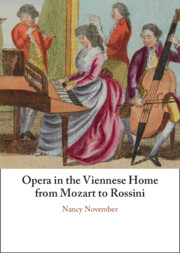Book contents
- Opera in the Viennese Home from Mozart to Rossini
- Opera in the Viennese Home from Mozart to Rossini
- Copyright page
- Contents
- Figures
- Tables
- Musical Examples
- Acknowledgements
- Introduction
- 1 Opera in the ‘Fruitful Age of Musical Translations’
- 2 Kenner und Liebhaber
- 3 Female Agency in the Early Nineteenth-Century Viennese Musical Salon
- 4 Canon Formation, Domestication, and Opera
- 5 Rossini ‘As the Viennese Liked It’
- 6 Industry, Agency, and Opera Arrangements in Czerny’s Vienna
- Bibliography
- Index
1 - Opera in the ‘Fruitful Age of Musical Translations’
Published online by Cambridge University Press: 18 February 2024
- Opera in the Viennese Home from Mozart to Rossini
- Opera in the Viennese Home from Mozart to Rossini
- Copyright page
- Contents
- Figures
- Tables
- Musical Examples
- Acknowledgements
- Introduction
- 1 Opera in the ‘Fruitful Age of Musical Translations’
- 2 Kenner und Liebhaber
- 3 Female Agency in the Early Nineteenth-Century Viennese Musical Salon
- 4 Canon Formation, Domestication, and Opera
- 5 Rossini ‘As the Viennese Liked It’
- 6 Industry, Agency, and Opera Arrangements in Czerny’s Vienna
- Bibliography
- Index
Summary
The period c.1780–c.1830, covered by this book, was a high point in the ‘fruitful age of musical translations’ (Beethoven). This trend was driven partly by the social and political circumstances, which made private and semi-private music-making particularly feasible and appealing, creating a demand for chamber music that was within the reach of the enthusiastic amateur. But the vogue for arrangements was also a function of the music publishing trade and its governance (or lack of it) around 1800. This chapter explores the vogue for opera in Vienna from the perspectives of composers, then through the lens of publishers’ catalogues, considering which types of opera and which composers were most liked, and how opera (in various ‘musical translations’) infiltrated into Viennese homes around 1800.
Keywords
- Type
- Chapter
- Information
- Opera in the Viennese Home from Mozart to Rossini , pp. 11 - 38Publisher: Cambridge University PressPrint publication year: 2024

